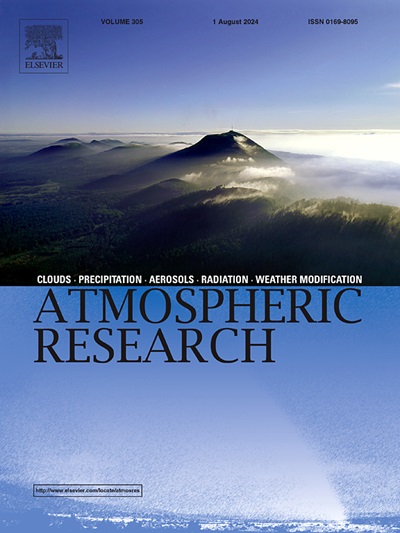评估气溶胶对城市降水的影响:达拉斯-沃斯堡的敏感性研究
IF 4.4
2区 地球科学
Q1 METEOROLOGY & ATMOSPHERIC SCIENCES
引用次数: 0
摘要
城市化影响对流层环流,特别是大城市周围。虽然城市热岛(UHI)对区域降雨的影响已被充分记录,但城市气溶胶对降水的影响仍存在较大的不确定性。本研究采用化学天气研究与预报模型(WRF-Chem)来研究气溶胶驱动的对德克萨斯州达拉斯-沃斯堡城市降水的影响,包括深层对流和层状事件。我们生成了一个WRF-Chem集合,该集合探索了多种情景,包括有和没有大气化学、气溶胶、土地利用扰动和背景排放改变的模拟,从而能够隔离降雨变率的关键物理和化学驱动因素。从这一分析中可以看出,城市和背景气溶胶通过云凝结核浓度、云水路径、潜热通量和垂直速度的变化对降水产生显著影响,从而影响云生命周期和风暴动力学。在分析的深层对流事件中,许多超细的人为气溶胶在低层大气中被激活,在干燥空气入侵下形成短暂的中性层。这一过程最初抑制对流;然而,随着系统的发展,对流通过增强的混合相过程逐渐增强,导致城市降水显著增加。在没有化学作用的模拟中,这种气溶胶驱动机制的缺失导致了对城市降雨强度的低估。相比之下,由于土地利用扰动和气溶胶,层状事件没有发现显著的变化。这些发现强调了气溶胶-云相互作用在城市气象学中的重要性,并为潜在地改善人口稠密地区的天气预报提供了见解。本文章由计算机程序翻译,如有差异,请以英文原文为准。
Assessing the influence of aerosols on urban precipitation: A sensitivity study of Dallas–Fort Worth
Urbanization influences tropospheric circulation, particularly around large cities. While the Urban Heat Island (UHI) effect on regional rainfall is well-documented, larger uncertainties still remain for urban aerosol’s effect on precipitation. This study employs the Weather Research and Forecasting model with Chemistry (WRF-Chem) to examine aerosol-driven modifications to urban precipitation in Dallas–Fort Worth, TX, during both a deep convective and a stratiform event. We generate a WRF-Chem ensemble that explores multiple scenarios, including simulations with and without atmospheric chemistry, aerosols, land use perturbations, and altered background emissions, enabling the isolation of key physical and chemical drivers of rainfall variability. From this analysis it emerges that urban and background aerosols exert a significant influence on precipitation affecting cloud life-cycle and storm dynamics through changes in cloud condensation nuclei concentrations, cloud water paths, latent heat fluxes, and vertical velocities. During the analyzed deep convective event, numerous ultrafine anthropogenic aerosols activated in the lower atmosphere, forming a transient neutral layer beneath an intrusion of dry air. This process initially suppressed convection; however, as the system evolved, convection progressively intensified through enhanced mixed-phase processes, resulting in a significant increase in urban precipitation. The absence of this aerosol-driven mechanism in the simulation without chemistry led to an underestimation of urban rainfall intensity. In contrast, no significant changes are found for the stratiform event due to land-use perturbation and aerosols. These findings highlight the importance of aerosol-cloud interactions in urban meteorology and provide insights for potentially improving weather forecasting in densely populated regions.
求助全文
通过发布文献求助,成功后即可免费获取论文全文。
去求助
来源期刊

Atmospheric Research
地学-气象与大气科学
CiteScore
9.40
自引率
10.90%
发文量
460
审稿时长
47 days
期刊介绍:
The journal publishes scientific papers (research papers, review articles, letters and notes) dealing with the part of the atmosphere where meteorological events occur. Attention is given to all processes extending from the earth surface to the tropopause, but special emphasis continues to be devoted to the physics of clouds, mesoscale meteorology and air pollution, i.e. atmospheric aerosols; microphysical processes; cloud dynamics and thermodynamics; numerical simulation, climatology, climate change and weather modification.
 求助内容:
求助内容: 应助结果提醒方式:
应助结果提醒方式:


